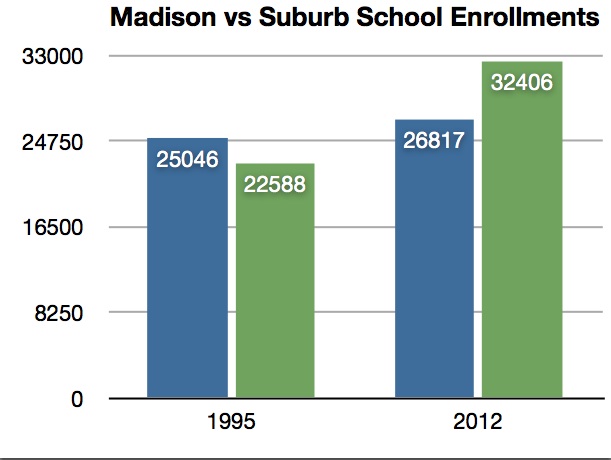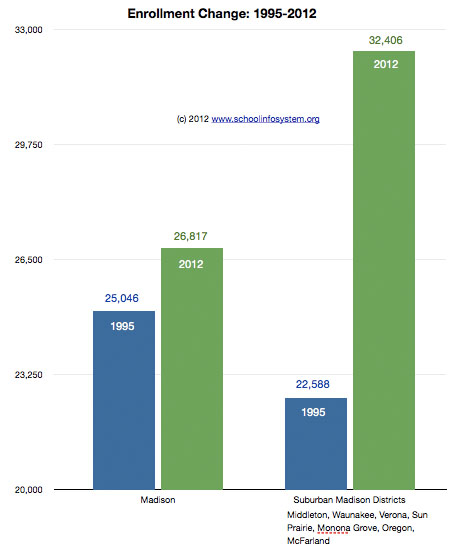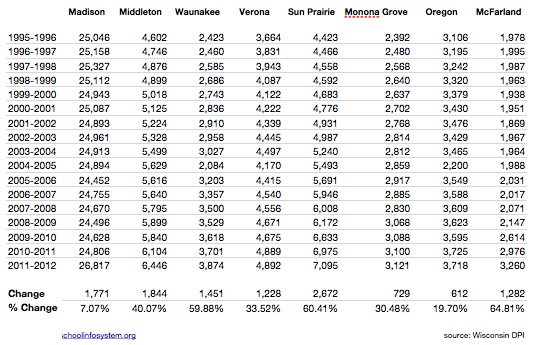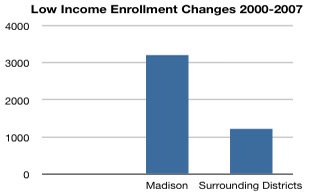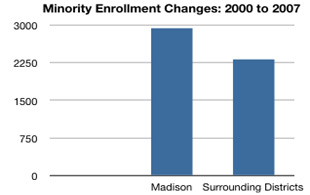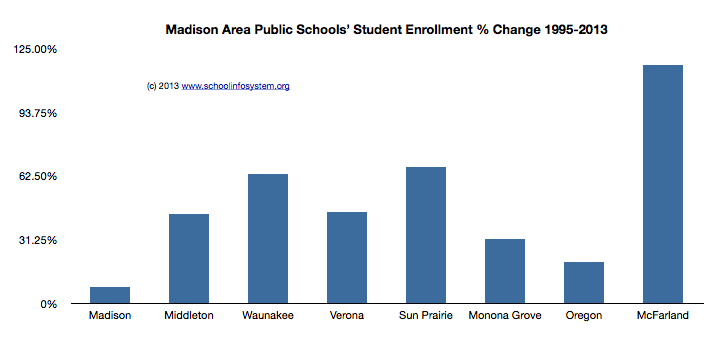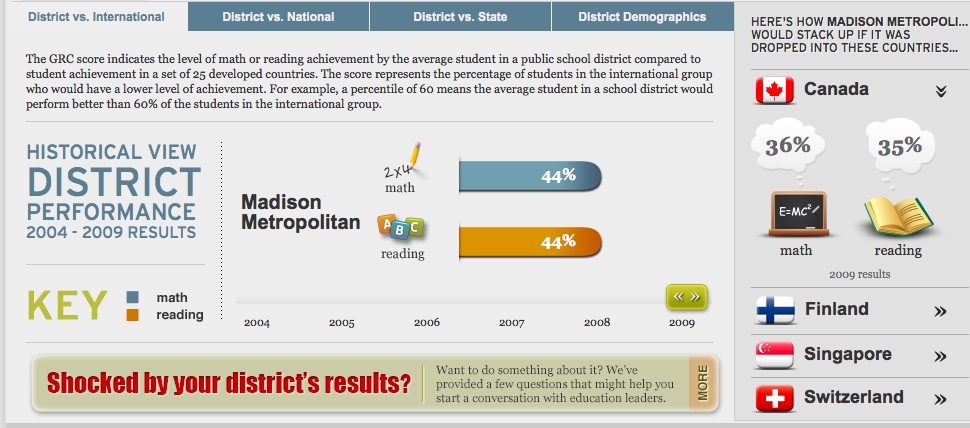Search Results for: We have all the students gone?
“Milwaukee ranks relatively high in total revenue per student compared to other large districts nationally” – Madison is higher, yet
Sara R. Shaw, Robert Rauh, Jeff Schmidt, Jason Stein and Rob Henken: We can show that by looking at the overall operating funds available to the district from local, state, and federal sources. Using a metric developed for the Forum’s School DataTool, we found that MPS had operating spending in the 2022 school year of […]
Madison Student Enrollment Projections and where have all the students gone?
Madison School District PDF: Executive Summary: As part of its long-range facility planning efforts, MMSD requires a refined approach for predicting enrollment arising from new development and changes in enrollment within existing developed areas. As urban development approaches the outer edges of the District’s boundary, and as redevelopment becomes an increasingly important source of new […]
“We are not interested in the development of new charter schools”
Larry Winkler kindly emailed the chart pictured above.
Where have all the Students gone?
Madison Mayor Paul Soglin:We are not interested in the development of new charter schools. Recent presentations of charter school programs indicate that most of them do not perform to the level of Madison public schools. I have come to three conclusions about charter schools. First, the national evidence is clear overall, charter schools do not perform as well as traditional public schools. Second where charter schools have shown improvement, generally they have not reached the level of success of Madison schools. Third, if our objective is to improve overall educational performance, we should try proven methods that elevate the entire district not just the students in charter schools. The performance of non-charter students in cities like Milwaukee and Chicago is dismal.
In addition, it seems inappropriate to use resources to develop charter schools when we have not explored system-wide programming that focuses on improving attendance, the longer school day, greater parental involvement and combating hunger and trauma.
We must get a better understanding of the meaning of ‘achievement gap.’ A school in another system may have made gains in ‘closing’ the achievement gap, but that does not mean its students are performing better than Madison students. In addition, there is mounting evidence that a significant portion of the ‘achievement gap’ is the result of students transferring to Madison from poorly performing districts. If that is the case, we should be developing immersion programs designed for their needs rather than mimicking charter school programs that are more expensive, produce inadequate results, and fail to recognize the needs of all students.
It should be noted that not only do the charter schools have questionable results but they leave the rest of the district in shambles. Chicago and Milwaukee are two systems that invested heavily in charter schools and are systems where overall performance is unacceptable.Related links:
- Notes and links on the rejected Madison Preparatory Academy IB Charter School. [Kaleem Caire video interview]
- Comparing Milwaukee Public and Voucher Schools’ Per Student Spending
- When all third graders read at grade level or beyond by the end of the year, the achievement gap will be closed…and not before (2005)
- “They’re all rich, white kids and they’ll do just fine” — NOT!
- Paul Soglin notes and links.
- Madison School District Open Enrollment Leavers Report, 2012-13 (2009 Open Enrollment Leaver Survey)
- Paul Vallas visits Madison; Enrollment Growth: Suburban Districts vs. Madison 1995-2012
- Where does MMSD get its numbers from?
- 60% to 42%: Madison School District’s Reading Recovery Effectiveness Lags “National Average”: Administration seeks to continue its use
- Minneapolis teacher’s union approved to authorize charter schools
I am unaware of Madison School District achievement data comparing transfer student performance. I will email the Madison School Board and see what might be discovered.
Pat Schnieder:Madison Mayor Paul Soglin has some pretty strong ideas about how to improve academic achievement by Madison school children. Charter schools are not among them.
In fact, Madison’s ongoing debate over whether a charter school is the key to boosting academic achievement among students of color in the Madison Metropolitan School District is distracting the community from making progress, Soglin told me.
He attended part of a conference last week sponsored by the Urban League of Greater Madison that he says overstated the successes elsewhere of charter schools, like the Urban League’s controversial proposed Madison Preparatory Academy that was rejected by the Madison School Board a year ago.
“A number of people I talked with about it over the weekend said the same thing: This debate over charter schools is taking us away from any real improvement,” Soglin said.
Can a new committee that Soglin created — bringing together representatives from the school district, city and county — be one way to make real progress?The City of Madison’s Education Committee, via a kind reader’s email. Members include: Arlene Silveira, Astra Iheukemere, Carousel Andrea S. Bayrd, Erik Kass, Jenni Dye, Matthew Phair, Maya Cole and Shiva Bidar-Sielaff.
Paul Vallas visits Madison; Enrollment Growth: Suburban Districts vs. Madison 1995-2012
Related:
- Where Have All the Students Gone (November, 2005)?
- Where Have all the Students Gone? An Update (January, 2008)
- Madison School District Outbound Open Enrollment.
- Open Enrollment Leavers Survey
Paul Vallas will be speaking at Madison LaFollette high school on Saturday, May 26, 2012 at 1:00p.m. More information, here.
Much more on Paul Vallas, here.
Directions.
Per Student Spending:
I don’t believe spending is the issue. Madison spends $14,858.40/student (2011-2012 budget)
Middleton’s 2011-2012 budget: $87,676,611 for 6,421 students = $13,654.67/student, about 8% less than Madison.
Waunakee spends $12,953.81/student about 13% less than Madison.
A few useful links over the past decade:
- Notes and links on Madison Superintendent hires since 1992 (2007).
- English 10
- Small Learning Communities
- Connected Math
- Reading Recovery
- When all third graders read at grade level or beyond by the end of the year, the achievement gap will be closed…and not before
- Madison School Board member may seek audit of how 2005 maintenance referendum dollars were spent
- Madison Preparatory Academy
The State of Education Today: Where Has All The Money Gone? Administrative Bloat
[ Ed. Note: In the immediate aftermath of the CSU Board of Trustees approving a salary of $400,000 — 25% more than his predecessor was paid — for the new President of San Diego State University on July 12, 2011, this piece is particularly appropriate.]
Higher education is very important to California — to the students, to their parents, to the employers who hire the graduates, and to the people and organizations that fund the portion of the costs that is not covered by tuition. Therefore it is extremely important that educational funding be spent as efficiently as possible, and even more so in this time of financial distress.
I have taught at two campuses in the California State University system since 1998. My personal experiences at those schools raised concerns about administrative practices. Further research revealed statistics that all the stakeholders should be aware of, because of their effects on both the cost and quality of the education we provide.
For example, based on data in the California State University Statistical Abstract, the number of full-time faculty in the whole CSU system rose from 11,614 to 12,019 between 1975 and 2008, an increase of only 3.5 percent. In the same time period the total number of administrators rose 221 percent, from 3,800 to 12,183. In 1975, there were three full time faculty members per administrator, but now there are actually slightly more administrators than full-time faculty. If this trend continues, there could be two administrators per full-time faculty in another generation.
I currently teach at Cal Poly in Pomona, where the trends for the whole system also are visible. In 1984 we had 90 “Management Personnel Plan” employees, but in 2010 there were 132. Based on data provided by the chief financial officer, the total compensation of those employees, including fringe benefits, was $20.6 million in 2010.
To put this total into perspective, if the administrators were reduced by 42 to return to the same level as in 1984, the university could hire over 50 full-time faculty (who are typically paid less than administrators). These additional faculty could teach over 300 additional classes per year, which would make it easier for students to graduate in a more timely fashion. The additional instructors would also make it unnecessary to eliminate academic programs as is currently being proposed.
Where Have all the Students Gone? An Update
An update to Barb Schrank’s November, 2005 post:
Comments from a reader:
At $6,000 per child that’s about $16 million per year. At $9,000 per child, that’s about $23 million per year. If we kept 332, that would be $2-3 million more per year.
Also, MMSD not only lost students, which has a negative effect on what the district gets under revenue caps, we’ve increased our low-income population, which means that for every dollar the district gets, more of those dollars need to be spent on non-instructional services.
If the district does not consider the economic development implications of its decisions, we’re likely to
- see more go to school outside MMSD, or
- for the non-low income students who go to school here increased family dollars will be spent on private aspects of education- lessons, tutoring, etc.
Madison’s population in 2000 was 208,054 and is estimated to be 223,389, according to the census bureau. Madison’s poverty rate is estimated to be 13%, according to the Small Area Estimates Branch [Website].
District Enrollment
2000-2001Enrollment
2006-2007Per Student Spending (06/07 Budget) Administrators Total Staff ACT % Tested (05-06) ACT Comp Score Madison 25,087 24,755 $12,422 91.5 3544.6 61.1 24.2 Verona 4222 4540 $12,113 22 603.4 69.6 23.6 Middleton-Cross Plains 5125 5640 $12,822 21 756.3 73 24.5 Waunakee 2836 3357 $11,987 14 427.6 70.7 23.3 Sun Priarie 4776 5946 $11,238 20 741.3 62.6 23 McFarland 1951 2017 $11,853 9.5 251.2 64 23.7 Monona Grove 2702 2885 $12,289 13 388 71.4 22.6 Oregon 3430 3588 $11,572 15 465.1 59.2 23.2 Data sources:
- Wisconsin Department of Public Instruction
- Wisconsin School District Poverty Estimates (2005)
- WISTAX SchoolFacts07
Thanks to a number of readers for the updated information.
“Politically Correct Trumps Substance Every Time”
Paul Soglin on Why the Prospects for Madison are so Bleak, Part II: “Struck by the number of residents who said if things don’t improve soon, they’ll consider moving elsewhere.” Good grief. Its been going on for over a decade and really picked up around 2000. The school enrollment figures clearly show that. And go […]
Where Have All the Students Gone?
Additional Charts: Enrollment Changes, Number of Minority Students | Enrollment Changes, Low IncomeMMSD Lost 174 Students While the Surrounding School Districts Increased by 1,462 Students Over Four School Years. Revenue Value of 1,462 Students – $13.16 Million Per Year* MMSD reports that student population is declining. From the 2000-2001 school year through the 2003-2004 school […]
Covid-19 and Madison’s K-12 World
Hi, I’m cap tines K-12 education reporter Scott Gerard. Today. Our cap times IDFs panel will discuss how will COVID-19 change K-12 education. I’m lucky to have three wonderful panelists with me to help answer that question. Marilee McKenzie is a teacher at Middleton’s Clark street community school, where she has worked since the school was in its planning stages.
She’s in her [00:03:00] 11th year of teaching. Dr. Gloria Ladson billings is a nationally recognized education expert who was a U w Madison faculty member for more than 26 years, including as a professor in the departments of curriculum and instruction, educational policy studies and educational leadership and policy analysis.
She is also the current president of the national Academy of education. Finally dr. Carlton Jenkins is the new superintendent of the Madison metropolitan school district. He started the districts top job in August, coming from the Robbinsdale school district in Minnesota, where he worked for the past five years, Jenkins began his career in the Madison area.
Having worked in Beloit and at Memorial high school in early 1990s before moving to various districts around the country. Thank you all so much for being here. Mary Lee, I’m going to start with you. You’ve been working with students directly throughout this pandemic. How has it gone? Both in the spring when changes were very sudden, and then this fall with a summer to reflect and [00:04:00] plan, it’s been interesting for sure.
Um, overall, I would say the it’s been hard. There has been nothing about this have been like, ah, It’s really, it makes my life easy. It’s been really challenging. And at the same time, the amount of growth and learning that we’ve been able to do as staff has been incredible. And I think about how teachers have moved from face-to-face to online to then planning for.
Madison Schools 2016 Property Tax Increase Referendum – Let’s Compare: Madison and Middleton Property Taxes
The Madison School District is considering another property tax increase referendum for the upcoming November election. We’ve long spent more than most districts (“plenty of resources”), despite challenging academic outcomes. I thought it might be useful to revisit the choices homeowners and parents make. I’ve compared two properties, one in Middleton (2015 assessment: $257,500.00) and […]
K-12 Tax & Spending Climate: Suburbs vs. Urban Markets
Joel Kotkin: Some suggest that the trends of the first decade of this century already are passé, and that more Americans are becoming born-again urbanistas. Yet after a brief period of slightly more rapid urban growth immediately following the recession, U.S. suburban growth rates began to again surpass those of urban cores. An analysis by […]
Are our suburban heads in the sand?
Erika Sanzi: Parents prefer relationships to data. Most of us enjoy people more than numbers and like parent teacher conferences better than bar graphs. We take comfort in knowing that our kids are being educated in a safe space and worry very little about the high school profile or SAT participation rate in our town. […]
Property Tax Increase Climate: Madison’s Proposed 2015 Spending Referendum
A variety of notes and links on the planned 2015 Madison School District Property Tax Increase referendum: Madison Schools’ PDF Slides on the proposed projects. Ironically, Madison has long supported a wide variation in low income distribution across its schools. This further expenditure sustains the substantial variation, from Hamilton’s 18% low income population to Black […]
“The notion that parents inherently know what school is best for their kids is an example of conservative magical thinking.”; “For whatever reason, parents as a group tend to undervalue the benefits of diversity in the public schools….”
Where have all the students gone?
Madison School Board President Ed Hughes:Esenberg sets out to identify the fundamental differences between voucher advocates and opponents. His thesis is that views on vouchers derive from deeper beliefs than objective assessments of how well voucher schools perform or concerns about vouchers draining funds from public schools. To him, your take on vouchers depends on how you view the world.
Esenberg asserts that voucher advocates are united by their embrace of three fundamental principles: that a centralized authority is unlikely to be able to decide what is best for all; that families should be trusted to select their children’s schools since ordinary people are capable of making choices for themselves without paternalistic direction; and that “government does not do diversity, experimentation and choice very well.”
By implication, he asserts that voucher opponents think that a centralized authority will be able to decide what’s best for all, that families shouldn’t be trusted to make choices for their children, and that government control is the best way to foster innovation.
And there you have it. Your views on school voucher expansion are entirely explained by whether you prefer individual freedom, like the voucher advocates, or stultifying government control, like the voucher opponents. In cinematic terms, voucher opponents are the legions of lifeless, gray drones in Apple’s famous 1984 commercial and voucher supporters are the colorful rebel, bravely challenging the control of Big Brother and hurling her sledgehammer to smash mindless conformity. You couldn’t ask for a more sophisticated analysis than that, could you?
While his thesis invites mockery, Esenberg’s short article does present a bit of a challenge to voucher opponents like myself. Can we set out a coherent justification for our opposition that doesn’t depend on the facts that voucher schools drain needed resources from public schools and don’t perform any better? Sweeping those fairly compelling points aside, Esenberg asks, in effect, what else you got?Mr Hughes anti-voucher rhetoric is fascinating on several levels:
1. The Madison School District’s long term, disastrous reading results. How much time and money has been wasted on anti-voucher rhetoric? Reading has long been job one.
2. Local private schools do not have much, if any availability.
3. Madison spends double the national average per student (some of which has been spent on program explosion). Compare Milwaukee Public and Voucher Schools’ Per Student Spending.
4. Madison’s inability to address its long-term disastrous reading results will bring changes from State or Federal legislation or via litigation.
5. Superintendent Cheatham cited Long Beach and Boston as urban districts that have “narrowed the achievement gap”. Both districts offer a variety of school governance models, which is quite different than Madison’s long-time “one size fits all approach”.
I recall being astonished that previous Madison School District administrators planned to spend time lobbying at the State level for this or that change – while “Rome is burning“. Ironically, Superintendent Cheatham recently said:“Rather than do a lot of work on opposing the voucher movement, we are going to focus on making sure our schools are the best schools possible and the schools of choice in Madison,” Cheatham said.
This points up one of the frustrating aspects of trying to follow school issues in Madison: the recurring feeling that a quoted speaker – and it can be someone from the administration, or MTI, or the occasional school board member – believes that the audience for an assertion is composed entirely of idiots.
A great, salient quote. I would hope that the District would focus completely on the matter at hand, disastrous reading scores. Taking care of that problem – and we have the resources to do so – will solve lots of other atmospheric and perception issues.
In closing, I sense politics in the voucher (and anti-open enrollment) rhetoric. Two Madison School Board seats will be on the Spring, 2014 ballot. One is currently occupied by Mr. Hughes, the other by Marj Passman. In addition, local politics play a role in becoming school board President.
Commentary on Wisconsin’s Proposed Voucher and Charter School Expansion
Stop the latest ploy by the WIGOP to destroy our public schools!The time to act is now: bit.ly/18zyVJW
— Madison Teachers Inc (@MtiMadison) May 30, 2013
Long term disastrous reading scores are the existential threat to our local public school “status quo” structure.
Related: Where Have all the Students Gone? Madison Area School District Enrollment Changes: 1995-2013.
A New Database on Educational Quality
I frequently have my undergrad and grad students read Bill Easterly’s excellent book, The Elusive Quest for Growth: Economists’ Adventures and Misadventures in the Tropics. They are often a bit depressed after reading the chapters on growth, noting how little we seem to know about growth in the real world. It is the education chapter, however, which really gets to them. In it, Easterly points out what has been known for ages but is rarely mentioned in print (see Lant Pritchett’s “Where has all the education gone?” for a refreshing exception), namely, that education is not positively and significantly related to economic growth for most samples. Sometimes you can find a weakly positive t-stat in a sample of OECD countries, but you are lucky if you merely find zero correlation (instead of a negative and significant) in the developing world.
Related www.wisconsin2.org.
“Voucher Voodoo: Smart Kids Shine Here” (Madison); A few links to consider
Tap on the image to view a larger version. Source: The Global Report Card.
Madison School Board Member Ed Hughes:Recently I’ve been spending a lot of time thinking about the Madison school district’s achievement gap problems and other challenges we face. I’ve also been responding to the outlandish notion that Madison is a failing school district whose students deserve private school vouchers as their only lifeline to academic success.
At times like this, I find it helpful to remember that Madison’s schools are educating many, many students who are succeeding. Some of them are succeeding spectacularly. With apologies to those I’m overlooking, here’s a brief run-down on some of our stars –
Madison Memorial’s recently-formed science bowl team won the Wisconsin state championship in January. The team of seniors Srikar Adibhatla, Sohil Shah, Thejas Wesley and William Xiang and sophomore Brian Luo will represent Wisconsin in the National Science Bowl Championship in Washington, D.C. in April.Related:
Credit for non-Madison School District courses and the Talented and Gifted complaint.
Census.gov on Madison’s demographics, compared to College Station, TX. 52.9% of Madison residents have a bachelor’s degree, compared to the State’s 26%. 57.5% of College Station, Texas’s residents have a college degree.
Madison High School UW-Madison and University of Wisconsin System enrollment trends 1983-2011:
East LaFollette, Memorial, West, Edgewood.
Where have all the students, gone? A look at suburban Madison enrollment changes.
National Merit Semifinalists & Wisconsin’s cut scores.
Madison’s nearly $15k per student annual spending, community support and higher education infrastructure provide the raw materials for world class public schools. Benchmarking ourselves against world leaders would seem to be a great place to begin.
Madison Schools enrollment remains steady at 24,622
via a Madison School District email:
Student enrollment in the Madison Metropolitan School District for the 2009-10 school year is up 82 students to 24,622 according to the official enrollment count conducted on the third Friday in September, as required by state law.
The 82 student rise over last year’s official enrollment count of 24,540 represents an increase of one third of one percent (0.33%).
Enrollment in Madison Schools has been remarkably consistent. This is the ninth straight year that MMSD enrollment has been between 24 and 25-thousand students.
Of note is the increase in the number of kindergarten students enrolled in Madison Schools. The count of 2,146 kindergarten students is:
- 140 students above last year’s number (2,006);
- the highest enrollment for that grade level in the last 15 years;
- nearly four percent greater than the most recent projection (80 students above 2,066 projection).
For more information on kindergarten-12th grade enrollment, go to http://infosvcweb.madison.k12.wi.us/stats
Related: “Where have all the students gone?” The student population drives a school district’s tax & spending authority.
No long-term plan, no research – fine-tuning of language policy reflects a lack of values
Jonathan Lai, principal, Lee Kau Yan Memorial School in San Po Kong:
This is an era of “NO Values” – that is confirmed! Ten years have passed since 1998 and the medium-of-instruction pendulum is swinging again. From one side to the other, or rather, back to square one, although the government refuses to admit the fact and gives the latest policy move a beautiful name: “fine-tuning”. Yet, who will feel fine? The Education Bureau? Parents? Teachers? Students?
While the community is deeply involved in the discussion about the so-called labelling effect that could be caused by the fine-tuning policy, what has made the pendulum swing back remains a complete mystery. No one will be interested in the mystery, they will be too busy getting their surfboards ready for the tide to turn again.
However, this mysterious force is pushing our community into an era without beliefs and values. The issue of teaching language should not be considered as something solely related to education, it should be viewed and discussed from a wider angle. It is, in fact, demonstrating how our government formulates and adjusts its public policies.
Let us have a look at the Education Bureau’s proposal. The officials are now suggesting that teachers hold a grade six in the International English Language Testing System (IELTS), considered appropriate to be able to conduct a lesson in English in the future.
What is IELTS? According to the official webpage www.ielts.org) , it is an internationally recognised English test measuring the ability of a student to communicate in English across all four language skills – listening, reading, writing and speaking – for people who intend to study or work where English is the language of communication.
Just like TOEFL, this is an English benchmarking test for students who wish to further their studies overseas and for people who are applying for migration to an English-speaking country.
Where to Educate Your Child? Madison Area is #2
Via a reader’s email: David Savageau (Contributing Editor of Expansion Management Management):
Three out of 10 of us either work in an educational institution or learn in one. Education eats up 8% of the Gross National Product. Keeping it all going is the biggest line item on city budgets. Whether the results are worth it sometimes makes teachers and parents–and administrators and politicians–raise their voices and point fingers.
In the 1930s, the United States was fragmented into 130,000 school districts. After decades of consolidation, there are now fewer than 15,000. They range in size from hundreds that don’t actually operate schools–but bus children to other districts–to giants like the Los Angeles Unified District, with three-quarters of a million students.
Greater Chicago has 332 public school districts and 589 private schools within its eight counties. Metropolitan Los Angeles takes in 35 public library systems. Greater Denver counts 15 public and private colleges and universities. Moving into any of America’s metro areas means stepping into a thicket of school districts, library systems, private school options and public and private college and universities.Here are some of their top locations:
- Washington, DC – Arlington, VA
- Madison, WI
- Cambridge-Newton-Framingham
- Baltimore -Towson
- Akron, OH
- Columbus, OH
- Albany-Schenectady-Troy, NY
- Syracuse, NY
- St. Louis, MO
- Ann Arbor, MI
The Madison area has incredible resources for our children. The key of course, is leveraging that and being open to working effectively with many organizations, something Marc Eisen mentioned in his recent article. Madison’s new Superintendent has a tremendous opportunity to leverage the community from curricular, arts, sports, health/wellness, financial and volunteer perspectives.
Related:
- Where have all the students gone?
- Madison School District small learning community Grant application(s) and history.
- My Life and Times with the Madison Public Schools.
- Update on Credit for Non-MMSD Courses.
The Madison area, which includes all of Dane County as well as immediately adjoining areas, was awarded A+ for class size and spending per pupil in public schools, and for the popularity of the city’s public library.
The greater Madison area scored an A for being close to a college town and for offering college options.
Private school options in the greater Madison area were graded at B+.
There has been some confusion in the response to the rankings because they lump together numerous school districts — urban, suburban and rural.The engineering-based program is just one example of the district’s willingness to bring college-level learning to his high school students. That effort appears to be paying off nationally, WISC-TV reported.
“It reinforces that what we’re trying to do as a district and as an area is working,” said Granberg. “And it’s getting recognized on a national level, not just a local or state level.”
“This is not a community that accepts anything but the best and so that bar is always high,” said Madison Metropolitan School District Superintendent Art Rainwater.
Rainwater also credits the ranking to teacher development programs.
“We spend an awful amount of time and an awful amount of effort working with our teachers in terms of how they deliver instruction to individual children,” said Rainwater.
He said the school district will continue to improve techniques, focusing on the needs of every student.
Wingra School proves that progressive education works. Could it be a model for a public charter school?
Inside Wingra School, the day is just beginning, and already Lisa Kass is commandeering a discussion about violence sparked by storyboards written by her fourth- and fifth-grade students.
“Why do you play violent videogames?” she asks. “Do you think the violence affects you?” This leads to a 45-minute discussion that temporarily pushes back a math lesson.
“It’s cartoon violence, it’s not real violence,” says one boy. “Well, really the goal is to kill people,” admits another. That, says a third student, is why he plays mostly strategy videogames.
The students at Wingra are articulate, reflective and eager to share their opinions. They refine their thoughts as Kass prods them to be more specific or clearer.
Kass, a 19-year veteran Wingra teacher, says later: “I don’t want to censor them, but I want them to think about what’s appropriate and what effects violence might have on them and others.”Related:
I Just Couldn’t Sacrifice My Son
When a high school friend told me several years ago that he and his wife were leaving Washington’s Mount Pleasant neighborhood for Montgomery County, I snickered and murmured something about white flight. Progressives who traveled regularly to Cuba and Brazil, they wanted better schools for their children. I saw their decision as one more example of liberal hypocrisy.
I was childless then, but I have a 6-year-old now. And I know better. So to all the friends — most but not all of them white — whom I’ve chastised over the years for abandoning the District once their children reached school age:
I’m sorry. You were right. I was wrong.
After nearly 20 years in the city’s Takoma neighborhood, the last six in a century-old house that my wife and I thought we’d grow old in, we have forsaken the city for the suburbs.Related:
- Where Have All the Students Gone?
- This is Not Your Grandchild’s Madison School District
- Promises Betrayed
Megan McArdle has more.
Denver’s Attempt to Address Their “Enrollment Gap”
Superintendent Michael Bennet and the Denver School Board: The Rocky Mountain News series, “Leaving to Learn [Denver Public Schools Enrollment Gap],” tells a painful and accurate story about the state of our school district. It is hard to admit, but it is abundantly clear that we will fail the vast majority of children in Denver […]
